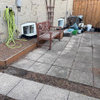Powdery Mildew on catnip indoors, HELP!
blackeyedgurl
14 years ago
Related Stories

CONTAINER GARDENSContainer Garden Basics: How and When to Water Potted Plants
Confused about soil moisture, the best time to water and what watering device to use? This guide can help
Full Story
GARDENING GUIDESAttract Hummingbirds and Bees With These Beautiful Summer Flowers
Roll out a welcome mat for pollinators to keep your landscape in balance and thriving
Full Story
CONTAINER GARDENS8 Easy Container Plants to Grow From Seed
Get beautiful blooms and herbs in summer by starting these choice garden picks from seed in spring
Full Story
WINTER GARDENINGPruning Secrets for Exquisite Roses
Encourage gorgeous blooms year after year with this time-tested advice on how to prune your rosebush in winter for health and shape
Full Story
GARDENING AND LANDSCAPING17 Outstanding Outdoor Rooms
Consider these creative possibilities for extending your living area outdoors
Full Story
EDIBLE GARDENSSummer Crops: How to Grow Squash
Almost foolproof and with cheerful flowers, squash comes in a wide range of varieties to plant in spring
Full Story
GARDENING GUIDESWhat Kind of Roses Should You Grow?
Want to add the beauty of roses to your garden? Find out which ones, from old-fashioned to modern, are right for you
Full Story
FLOORS5 Benefits to Concrete Floors for Everyday Living
Get low-maintenance home flooring that creates high impact and works with home styles from traditional to modern
Full Story
GARDENING GUIDES20 Favorite Flowers for Butterflies and Bouquets
Discover perennials and annuals that do double duty as butterfly magnets and versatile cut flowers
Full Story
GARDENING GUIDESTexas Gardener's May Checklist
Be especially water wise this month as you sow seeds, tend to your lawn and plant edibles, grasses and flowers
Full Story







justaguy2
wesley_butterflies
Related Professionals
Fillmore Landscape Architects & Landscape Designers · New Mexico Landscape Architects & Landscape Designers · Americus Landscape Contractors · Miller Place Landscape Contractors · Rockville Landscape Contractors · Seymour Landscape Contractors · University City Landscape Contractors · Vashon Landscape Contractors · Boise Decks, Patios & Outdoor Enclosures · Del Aire Decks, Patios & Outdoor Enclosures · Norman Decks, Patios & Outdoor Enclosures · Rosemont Decks, Patios & Outdoor Enclosures · Salt Lake City Decks, Patios & Outdoor Enclosures · Southampton Decks, Patios & Outdoor Enclosures · Eustis Decks, Patios & Outdoor EnclosuresKimmsr
gardengal48 (PNW Z8/9)
serenasyh
gardengal48 (PNW Z8/9)
ericwi
serenasyh
valerie_ru
blackeyedgurlOriginal Author
Kimmsr
P. Michael Hutchins
rhizo_1 (North AL) zone 7
P. Michael Hutchins